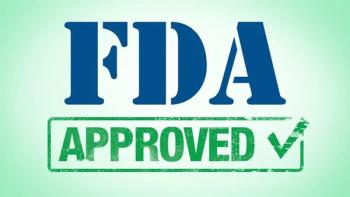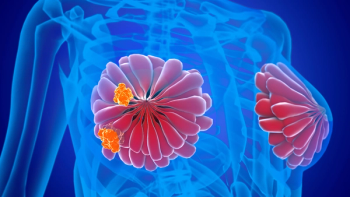
FDA Approves Pertuzumab Biosimilar in Breast Cancer Indications
The FDA has approved a biosimilar of pertuzumab which is indicated for multiple breast cancer settings.
The FDA has approved a biosimilar of pertuzumab-dpzb biosimilar (Perjeta) called Poherdy, which is indicated for use in multiple breast cancer settings.1
Pertuzumab is indicated for use in combination with trastuzumab and docetaxel for adults with HER2-positive metastatic breast cancer (mBC) who have not received prior anti-HER2 therapy or chemotherapy for metastatic cancer; in combination with trastuzumab and chemotherapy as neoadjuvant treatment of adults with HER2-ppositive, locally advanced, inflammatory, or early-stage breast cancer that is either greater than 2 cm in diameter or node positive as part of a complete treatment regimen for early breast cancer; or in combination with trastuzumab and chemotherapyadjuvant treatment of adults with HE2-positive early breast cancer at high risk of recurrence.
Poherdy’s Pipeline to Approval
The FDA accepted a biologics license application (BLA) for Poherdy in February, according to a news release from Shanhai Henlius Biotech, Inc.2 The FDA’s acceptance of the BLA and its approval of the biosimilar today are based on a series of studies comparing it with Perjeta.
The news release from February states that the first trial was a randomized, double-blind, single-dose, parallel-controlled, 4-arm phase 1 study (NCT04411550) that compared the pharmacokinetics, safety, and immunogenicity of Poherdy (formerly known as HLX11) in healthy male Chinese patients with pertuzumab from the US, Europe, and China administered intravenously.
The second study was a multicenter, randomized, double-blind, parallel-controlled phase 3 trial (NCT05346224) comparing the efficacy and safety of HLX11 with European-sourced reference pertuzumab as a neoadjuvant therapy in patients with HER2-positive, HR-negative early, or locally advanced breast cancer.
Data from the former study published in BioDrugs in 2022 revealed that the study established pharmacokinetic bioequivalence by having the 90% CI of the geometric mean ratios for each primary end point fall between 8.0% and 125.0%.3
The study’s primary end points were maximum serum drug concentration, area under the serum concentration-time curve (AUC) from time 0 to time of the last quantifiable concentration, and AUC from time 0 to infinity.
The trial included a 28-day screening period with a 99-day follow-up period. Patients were assigned 1:1:1:1 to Poherdy, US-pertuzumab, EU-pertuzumab, and CN-pertuzumab. Patients were assigned to treatment 1 day before infusion. Patients received a single 420-mg dose of their respective therapy administered intravenously. Treatment was given along with 5 mg of dexamethasone intravenously and 125 mg of promethazine hydrochloride intramuscularly 30 minutes before study drug infusion to mitigate the risk of infusion-related reactions.
Patients were required to stay at their respective research centers, with investigator supervision the day before study drug administration and 96 hours after study drug administration. Patients returned to the research center for follow-up on days 8, 15, 29, 50, 71, and 99 after dosage.
Follow-ups included pharmacokinetic and anti-drug antibody (ADA) blood draws and routine laboratory examinations, including N-terminal pro-brain natriuretic peptide, routine blood and urine labs, and blood chemistry testes, along with collection of information on adverse effects (AEs) as well as concurrent medications.
What is the Safety of Poherdy?
The frequency and severity of treatment-emergent adverse effects (TEAEs) were similar between biosimilar and reference drug arms. TEAEs occurred in 97.5% of those receiving the biosimilar, 97.5% of those receiving US-pertuzumab, 97.5% of those receiving EU-pertuzumab, and 90.0% in the CN-pertuzumab group.
The most frequent TEAEs reported across arms were leukocytosis (54.4%), proteinuria (36.9%), urinary tract infection (28.1%), diarrhea (26.3), mouth ulceration (18.8%), and hyperuricemia (15.6%).
References
- FDA approves new interchangeable biosimilar to Perjeta. FDA. November 13, 2025. Accessed November 13, 2025. https://www.fda.gov/drugs/resources-information-approved-drugs/fda-approves-new-interchangeable-biosimilar-perjeta
- US FDA accepts biologics license application (BLA) for HLX11, biosimilar candidate of Perjeta® (pertuzumab). Shanghai Henlius Biotech, Inc. News release. February 2, 2025. Accessed November 13, 2025. https://www.henlius.com/en/NewsDetails-4853-26.html
- Yang J, Lin L, Long Q, et al. HLX11, a proposed pertuzumab biosimilar: pharmacokinetics, immunogenicity, and safety profiles compared to three reference biologic products (US-, EU-, and CN-Approved Pertuzumab) administered to healthy male subjects. BioDrugs. 2022;36(3):393-409. doi:10.1007/s40259-022-00534-w
Newsletter
Knowledge is power. Don’t miss the most recent breakthroughs in cancer care.





















































































